
Euphorbia is a very large and diverse genus of flowering plants, commonly called spurge, in the spurge family (Euphorbiaceae). "Euphorbia" is sometimes used in ordinary English to collectively refer to all members of Euphorbiaceae, not just to members of the genus. Some euphorbias are commercially widely available, such as poinsettias at Christmas. Some are commonly cultivated as ornamentals, or collected and highly valued for the aesthetic appearance of their unique floral structures, such as the crown of thorns plant. Euphorbias from the deserts of Southern Africa and Madagascar have evolved physical characteristics and forms similar to cacti of North and South America, so they are often incorrectly referred to as cacti. Some are used as ornamentals in landscaping, because of beautiful or striking overall forms, and drought and heat tolerance.

Euphorbia esula, commonly known as green spurge or leafy spurge, is a species of spurge native to central and southern Europe, and eastward through most of Asia north of the Himalaya to Korea and eastern Siberia.

Aphthona is a genus of beetle, in the leaf beetle family Chrysomelidae, native to Europe and Asia. More specifically, Aphthona are flea beetles, meaning they have enlarged hind legs for jumping away from potential danger. There are some 300 species known worldwide.

Euphorbia cyparissias, the cypress spurge, is a species of plant in the genus Euphorbia. It is native to Europe and was introduced to North America in the 1860s as an ornamental plant.

Euphorbia myrsinites, the myrtle spurge, blue spurge, or broad-leaved glaucous-spurge, is a succulent species of flowering plant in the spurge family Euphorbiaceae.
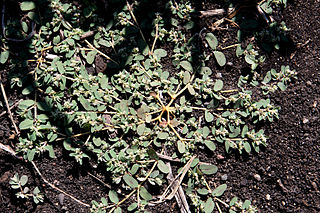
Euphorbia maculata, known as spotted spurge or prostrate spurge, the latter name not to be confused with Euphorbia prostrata, is a fast-growing annual plant in the family Euphorbiaceae, native to North America. It is a common garden and lawn weed in the United States.

Euphorbia corollata is an herbaceous perennial plant in the family Euphorbiaceae that is native to North America. A common name for the species is flowering spurge. It has a milky sap that can cause skin and eye irritation in some people. It grows up to 1 m (3 ft) tall, with smooth stems and light green leaves arranged alternately or in whorls. Leaves are about 10 mm wide and 75 mm (3 in) long. Each stem terminates in a panicle 20 to 25 mm across. Flowers are about 6 mm across and consist of one pistillate and several staminate flowers surrounded by five white bracts - not petals but formed from the involucre at the base of the flowers. Flowering spurge blooms from June to September.

Euphorbia dentata is a species of spurge known by the common names toothed spurge and green poinsettia. It is native to parts of North and South America, and is present elsewhere on the continents. Its true native range is uncertain. It is a noxious weed in some areas. This is a hairy annual herb with an erect or somewhat erect stem reaching anywhere from 20 to 50 centimeters tall. Its hairy, pointed leaves are a few centimeters long, widely to narrowly lance-shaped, and generally toothed. The inflorescence appears at the end of branches and contain cream or yellowish staminate or pistillate flowers just a few millimeters wide. The fruit is a lobed spherical or heart-shaped capsule about half a centimeter wide which contains three bumpy rounded seeds.
Pinnacle Natural Area Preserve is an 891-acre (361 ha) Natural Area Preserve in Russell County, Virginia. Located at the confluence of the Clinch River and Big Cedar Creek, the preserve's namesake and centerpiece is the Pinnacle, a dolomite formation rising 400 feet (120 m) above the creek.

The Euphorbiaceae, the spurge family, are a large family of flowering plants. In common English, they are sometimes called euphorbias, which is also the name of a genus in the family. Most spurges, such as Euphorbia paralias, are herbs, but some, especially in the tropics, are shrubs or trees, such as Hevea brasiliensis. Some, such as Euphorbia canariensis, are succulent and resemble cacti because of convergent evolution. This family has a cosmopolitan distribution, with greatest diversity in the tropics. However, the Euphorbiaceae also have many species in nontropical areas of all continents except Antarctica.
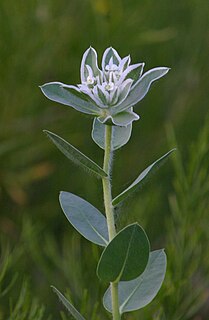
Euphorbia marginata is a small annual in the spurge family.

Chamaesphecia hungarica, the Hungarian clearwing moth, is a moth of the family Sesiidae. It is native to the south-eastern Czech Republic and Slovakia, Austria, Hungary, Serbia and Croatia. It was originally approved for introduction into the United States in 1993. It has been released at several leafy spurge-infested sites in Montana and North Dakota.

Euphorbia pubentissima, commonly called the southeastern flowering spurge or false flowering spurge, is a species of plant in the spurge family. It is native to the Southeastern United States where it is found in areas of sandy, open woodlands. It produces small flowers surrounded by white involucral gland appendages from spring to fall.
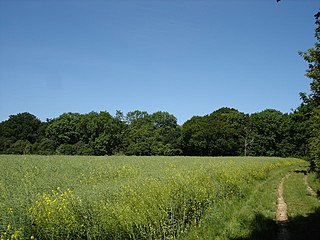
Gosbeck Wood is a 22.8 hectare biological Site of Special Scientific Interest east of Needham Market in Suffolk.

Euphorbia missurica, commonly called prairie sandmat, or Missouri spurge, is a species of flowering plant in the spurge family (Euphorbiaceae). It is native to North America, where it is found primarily in area of the Great Plains. Its natural habitat is in dry, often calcareous areas, including glades, bluffs, and open woodlands.

Euphorbia virgata, commonly known as leafy spurge, wolf's milk leafy spurge, or wolf's milk is a species of spurge native to Europe and Asia, and introduced in North America, where it is an invasive species.
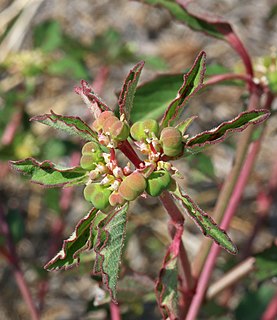
Euphorbia davidii, known as David's spurge or toothed spurge, is a species of flowering plant in the spurge family Euphorbiaceae.

Euphorbia mesembryanthemifolia, commonly called seaside spurge, is a species of flowering plant in the spurge family (Euphorbiaceae). It is native to the Western Hemisphere, where it is found in coastal areas from Florida in the United States south to Colombia and Venezuela, as well as in Bermuda and the Caribbean. Its natural habitat is on beaches and rocky shores.
Nance Wood is a woodland Site of Special Scientific Interest (SSSI) near Portreath, west Cornwall. The site was first notified in 1951 for its almost pure dwarf, sessile oak coppiced woodland, good bryophyte flora and Irish spurge, which is found in only two localities in Britain.
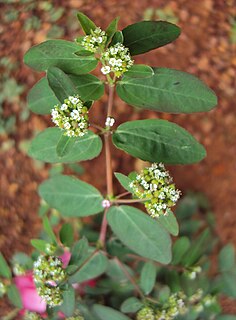
Euphorbia hypericifolia is a species of perennial herb in the genus Euphorbia native to tropical Americas. It can grow up to 2 feet (0.6 m) in height, and contains milky sap which can cause skin and eye irritation.


















